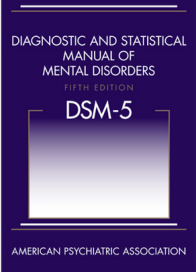8.1 Introduction to Psychological Disorders
3 min read•january 13, 2023
Dalia Savy
Emily Pedrazzi
Jillian Holbrook
AP Psychology 🧠
334 resourcesSee Units
Diagnostic Guidelines
In order to properly diagnose a patient in a formal setting, clinical psychiatrists and psychologists use defined guidelines and symptom lists from the Diagnostic and Statistical Manual of Mental Disorders Edition 5 (DSM-5 ). 📖 All conditions in the DSM-5 are recognized by the American Psychological Association (APA). The DSM was revised to the 5th edition in 2013.
DSM Edition by Year Published
DSM-1 | DSM-2 | DSM-3 | DSM-4 | DSM-5 |
1952 | 1968 | 1980 | 1994 | 2013 |

Image Courtesy of Wikipedia.
Even though the DSM-5 is highly reliable and provides descriptions for every disorder with a variety of treatments, it can sometimes be hard to diagnose somebody because symptoms may become too similar.
Psychological Disorders
Something becomes a disorder once it interferes with an individual's daily life, schedule, and quality of living. A psychological disorder impacts one's cognition, emotion, or behavior, and these behaviors are maladaptive. This means that they disrupt everyday life rather than improve it as adaptive behaviors do.
The DSM-5 classifies disorders by categories:
- Depressive Disorders—extreme sadness and loss of interest
- Bipolar Disorders—depression and mania
- Anxiety Disorders—fear and worry
- Obsessive-Compulsive and Related Disorders—obsessions and compulsions
- Trauma and Stressor Related Disorders
- Dissociative Disorders—amnesia
- Somatic Disorders
- Eating Disorders
Historical Conceptions of Psychological Disorders
The root of psychiatric conditions based on perception has drastically changed through history, going through three etiologies: supernatural, somatogenic, and psychogenic. In some cases, multiple etiologies were used at the same time.
- Those believing in a supernatural etiology believed mental illness was caused by supernatural phenomena such as possession, emotion of the gods, or astrology and astronomy-related events. 💫 One of the earliest proposed solutions was trephination. Holes were drilled into the skulls of people perceived to be mentally ill in order to release evil spirits. 👻
- Popularized by Hippocrates and Galen, the somatogenic etiology relies on the principle that the root of psychological illness was due to a physiological cause. One of the earliest somatogenic theories was humorism. With humorism, each person had to balance four different fluids: blood, black bile, phlegm, and yellow bile. To resolve an imbalance in blood, a popular technique was blood-letting (a process where blood is drained). Aromatherapy is another common example of humorism. 🕯️
- The most recently discovered etiology is psychogenic, which states that mental illness is psychological instead of physiological or supernatural. Psychogenic is the most commonly used approach in modern times, followed by some elements of somatogenic etiology. 🧠
Psychological Conditions in Legal Settings
In both courtrooms and clinical psychology/psychiatry offices, legalities exist in order to protect the patient 🛡️
Confidentiality laws protect a patient from potential discrimination or other negative implications by protecting almost all information presented during a psychological health session. In the United States, patient confidentiality can be broken to authorities and health workers if a patient is seen as a danger to themselves or others. 🙊
In a court of law, mentally ill patients, in certain circumstances, can plead legally insane, which is a claim that the defendant performed the action but cannot be held responsible as a result of a psychiatric episode. This situation is called an insanity plea or insanity defense. ⚖️
Browse Study Guides By Unit
🔎Unit 1 – Scientific Foundations of Psychology
🧠Unit 2 – Biological Basis of Behavior
👀Unit 3 – Sensation & Perception
📚Unit 4 – Learning
🤔Unit 5 – Cognitive Psychology
👶🏽Unit 6 – Developmental Psychology
🤪Unit 7 – Motivation, Emotion, & Personality
🛋Unit 8 – Clinical Psychology
👫Unit 9 – Social Psychology
✏️Frequently Asked Questions
🧐Multiple Choice Questions (MCQ)
✍️Free Response Questions (FRQ)
📆Big Reviews: Finals & Exam Prep

Fiveable
Resources
© 2023 Fiveable Inc. All rights reserved.